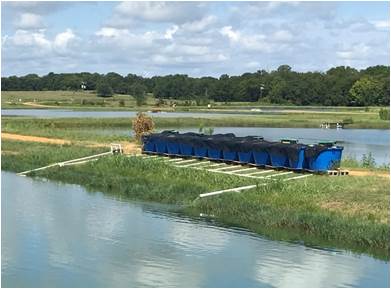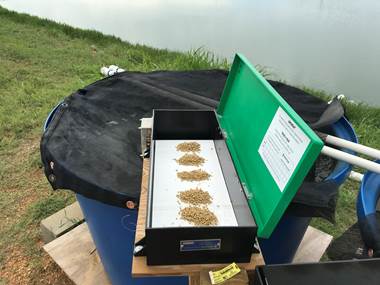 |
December 2020
|
December 2020 // Volume 58 // Number 6 // Tools of the Trade // v58-6tt6
Tank Systems on Shrimp Farms Are Effective for Extension Demonstrations in Aquaculture
Abstract
Numerous approaches can be implemented to carry out on-farm Extension demonstrations in aquaculture. The design and approach used are often governed by the problem or question that needs to be addressed as well as budgetary constraints within Extension programs. West Alabama is home to a unique inland marine shrimp industry that uses a low-salinity artesian groundwater source to raise shrimp. Demonstration and technology transfer have been carried out on commercial shrimp farms for nearly 20 years using low-budget on-levee tank systems operated by Extension personnel using this unique water source. On-farm tank demonstrations can be an effective tool for Extension professionals working in aquaculture, especially where unique circumstances exist.
Introduction
As with other agricultural sectors, the demonstration and transfer of new technology to the commercial aquaculture industry can be accomplished through use of various approaches. Extension is a vital link between aquaculture research carried out by state land-grant institutions and the eventual implementation of these discoveries on commercial farms. On-farm demonstrations are valuable tools used by Extension professionals to showcase and test new technologies in agriculture and fisheries (J. Cook, 2018; Lieser et al., 2005; MacGowan et al., 2018). In some circumstances, such as those described herein, on-farm demonstrations versus those implemented at research facilities are imperative.
On-Farm Tank Demonstration Systems
Within aquaculture, as in other agricultural fields, the transfer of research findings from land-grant universities to the farm is essential for industry growth (Snyder, 1992). In states with established aquaculture industries, farmers often point out that the culture water available at university-based research facilities is markedly different from pond water on their commercial farms in terms of water quality and composition, including parameters such as total alkalinity, total hardness, and pH, among others. This difference in water quality parameters is even more pronounced for shrimp farmers in west Alabama who use a unique low-salinity artesian well water source to fill earthen ponds to culture a marine shrimp species (Boyd et al., 2009; M. R. Cook, 1997; Davis et al., 2005; Roy et al., 2010). In west Alabama, farmers raise a euryhaline marine species of shrimp, the Pacific white shrimp (Litopenaeus vannamei), at distances that often exceed 150 mi north of the Gulf of Mexico (Roy et al., 2010, 2020a, 2020b). In addition to having a much lower salinity than seawater (1.5–11 parts per thousand salinity compared to 34.5 parts per thousand salinity in seawater), the culture water contains a much different ionic profile having markedly different concentrations of sodium, potassium, magnesium, and calcium compared to seawater (Boyd et al., 2007; Pine & Boyd, 2010; Roy et al., 2010; Saoud et al., 2003). Although Auburn University has a 1,850-ac research station near campus as well as marine research facilities on the Gulf Coast, the culture water available for this group of shrimp farmers is markedly different from culture water available at existing university research facilities.
The low-salinity well water source available for marine shrimp production and the geographical isolation of the target commercial farms required a unique approach to administering demonstrations of available technologies to improve production using this unique culture medium. Initial work in the early 2000s was logistically challenging and was carried out at the E. W. Shell Fisheries Research Station at Auburn University. This work comprised mainly laboratory-based experiments used to test the effects of various pond water amendments on shrimp performance. Pond water from west Alabama shrimp farms was often transported in large hauling tanks and stored in reservoir tanks to carry out small-scale aquarium and tank trials with shrimp on university facilities close to campus (Saoud et al., 2003). Although these efforts yielded valuable data, it became clear that an on-farm approach to carrying out research and demonstration would be a more efficient, cost-effective, and beneficial method for assisting west Alabama commercial shrimp producers. The on-farm approach also would allow for research and demonstration to coincide simultaneously on commercial shrimp farms in west Alabama.
Several on-farm demonstration tank systems of different configurations and sizes have been set up to solve these issues since the early 2000s on four shrimp farms in Alabama (Figure 1). These tank systems are relatively inexpensive to build, and one individual can manage daily maintenance and husbandry. The components of a basic 12-tank system, including tanks, plumbing supplies, lumber, pump, regenerative blower, automatic feeders, and a few additional items, can be purchased for approximately $10,000 (Figures 1 and 2, Table 1). Typically, the tank systems are set up on levees adjacent to commercial shrimp production ponds and designed to circulate water through the tank system and back to the pond. However, the systems also can be set up to run static or with minimal water exchange.
Figure 1.
On-Farm Tank Demonstration System at Commercial Shrimp Farm in Greene County, Alabama

| Item | Cost |
|---|---|
| Tanks (12, 800 L) | $4,000 |
| Plumbing supplies | $700 |
| Pump | $430 |
| Regenerative blower | $360 |
| Fittings, airline tubing, air stones | $800 |
| Lumber | $700 |
| Cinder blocks (to support tanks) | $120 |
| Baby belt feeders (12) | $300 |
| Bird netting | $100 |
| Total | $10,210 |
Figure 2.
Belt Feeder Used for Disbursing Feed to Shrimp Cultured in Demonstration System at Commercial Shrimp Farm in Greene County, Alabama

These on-farm tank systems have been used for demonstrating the utility of alternative feed ingredients, feed management regimes, alternative culture species besides shrimp, and novel lower cost salt formulations and for evaluating optimal stocking densities and robustness of shrimp sourced from different hatcheries (Figure 3). In addition to providing farmers with hands-on demonstrations to help solve production-related issues and to demonstrate new technology, because sufficient replications (tanks) are available, a number of these demonstrations have been published in peer-reviewed scientific journals. Although we have primarily used these on-farm tank systems for demonstration with shrimp, they also would be suitable for demonstration efforts with a number of fish species relevant to commercial aquaculture.
Figure 3.
Pacific White Shrimp for Which Various On-Farm Tank Systems Have Been Established in Alabama for Demonstration of New Culture Techniques

Conclusion
On-farm tank demonstration systems can be an effective tool for Extension professionals working in the field of aquaculture. These demonstration systems are incredibly valuable for farms that are located at great distances from state land-grant universities or have culture water that is unique in terms of water quality and composition. If managed correctly, tank demonstration systems also can serve as sources of Extension, trade journal, and peer-reviewed journal articles, which are increasingly becoming more important for promotion and tenure of Extension faculty and professionals. Although conducting on-farm Extension demonstrations can be challenging, Extension professionals must increasingly use innovative approaches to carry out relevant and practical on-farm technology transfer via traditional and nontraditional demonstration techniques.
Author Note
We acknowledge the Alabama commercial shrimp producers who opened their farms for demonstration projects over the years, including Greene Prairie Aquafarm, Odom Farms, Forkland Springs, and West Alabama Aquaculture. We thank Dr. Anita Kelly for helpful comments on an earlier version of our manuscript. We also would like to acknowledge HATCH projects ALA016-19053 and ALA016-08027 as well as U.S. Department of Agriculture (USDA) Agriculture Research Service Cooperative Agreement Number 58-6010-9-007. Finally, we would like to acknowledge the USDA National Institute of Food and Agriculture (NIFA) Small Business Innovation Research program and the USDA NIFA Small and Medium Farms program for providing funds for on-farm Extension demonstration efforts in aquaculture.
Correspondence concerning this article should be addressed to Luke A. Roy. Email: royluke@auburn.edu
References
Boyd, C. A., Boyd C. E., & Rouse, D. B. (2007). Potassium budget adsorption by bottom soils in ponds for inland culture of marine shrimp in Alabama. Journal of the World Aquaculture Society, 38, 85–91. https://doi.org/10.1111/j.1749-7345.2006.00076.x
Boyd, C. A., Chaney, P. L., Boyd, C. E, & Rouse, D. B. (2009). Distribution of ground water suitable for use in saline-aquaculture in central and west-central Alabama. Journal of Applied Aquaculture, 21, 228–240. https://doi.org/10.1080/10454430903114048
Cook, J. (2018). Grazing demonstration plots help managers understand grazing concepts. Journal of Extension, 56(6), Article v56-6tt1. https://www.joe.org/joe/2018october/tt1.php
Cook, M. R. (1997). Origin and evolution of anomalous hydrogeochemical character of Tuscaloosa aquifer system of west central Alabama [Unpublished doctoral dissertation]. University of Alabama.
Davis, D. A., Saoud, I. P., Boyd, C. E., & Rouse, D. B. (2005). Effects of potassium, magnesium, and age on growth and survival of Litopenaeus vannamei post-larvae reared in inland low salinity well waters of west Alabama. Journal of the World Aquaculture Society, 36, 416–419. https://doi.org/10.1111/j.1749-7345.2005.tb00346.x
Lieser, J. P., Zoller, C., & Clark, R. (2005). Using electrofishing demonstrations to increase water quality awareness. Journal of Extension, 43(6), Article 6IAW4. https://www.joe.org/joe/2005december/iw4.php
MacGowan, B. J., Singh, A. S., Overstreet, B., O'Donnell, M., Klotz, H., & Prokopy, L. A. (2018). Producers' opinions on what makes demonstrations effective. Journal of Extension, 56(2), Article v56-2rb7. https://www.joe.org/joe/2018april/rb7.php
Pine, H. J., & Boyd, C. E. (2010). Adsorption of magnesium by bottom soils in inland brackish water shrimp ponds in Alabama Journal of the World Aquaculture Society, 41, 603–609. https://doi.org/10.1111/j.1749-7345.2010.00400.x
Roy, L. A., Davis, D. A., Saoud, I. P., Boyd, C. A., Pine, H. J., & Boyd, C. E. (2010). Shrimp culture in inland low salinity waters. Reviews in Aquaculture, 2, 191–208. https://doi.org/10.1111/j.1753-5131.2010.01036.x
Roy, L. A., Teichert-Coddington, D., Beck, B. H., Dahl, S., James, J., Guo, J., & Davis, D. A. (2020a). Evaluation of stocking density and fish meal inclusion level for intensive tank production of Pacific white shrimp Litopenaeus vannamei in low salinity water. North American Journal of Aquaculture, in press. https://doi.org/10.1002/naaq.10150
Roy, L. A., Teichert-Coddington, D., Dahl, S., Beck, B. H., Shoemaker, C. A., Whitis, G. N., & James, J. (2020b). On-farm evaluation of three different hatchery sources of Pacific white shrimp (Litopenaeus vannamei) cultured in on-levee tanks in low salinity waters of west Alabama. Journal of Applied Aquaculture, 82(3), 345–353. https://doi.org/10/1080/10454438.2019.1614510
Saoud, I. P., Davis, D. A., & Rouse, D. B. (2003). Suitability studies of inland well waters for Litopenaeus vannamei culture. Aquaculture, 217, 373–383. https://doi.org/10.1016/S0044-8486(02)00418-0
Snyder, F. L. (1992). Aquaculture opportunities. Journal of Extension, 30(3), Article 3FEA7. https://www.joe.org/joe/1992fall/a7.php




